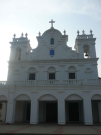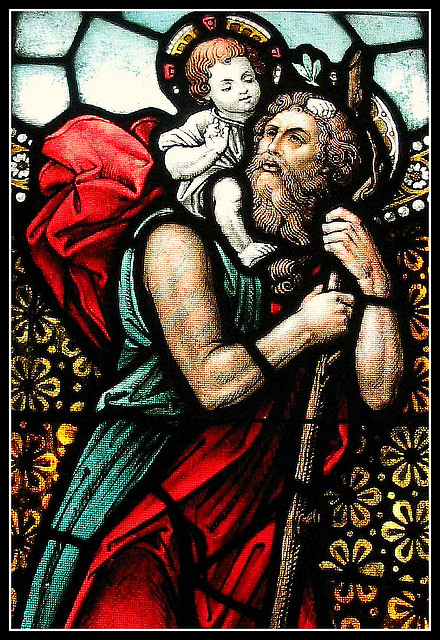
St. Christopher

St. Christopher (Greek: Ἅγιος Χριστόφορος, Ágios Christóforos) is venerated by several Christian denominations as a martyr killed in the reign of the 3rd-century Roman Emperor Decius (reigned 249–251) or alternatively under the Roman Emperor Maximinus II Dacian (reigned 308–313). St. Christopher’s veneration only appears late in Christian tradition, and did not become widespread in the Western Church until the Late Middle Ages, although churches and monasteries were named after him by the 7th century.
Christopher the name, means “Christ-bearer”, St. Christopher’s most famous legend, which is mainly known from the West and may draw from Ancient Greek mythology, says that he carried a child, who was unknown to him, across a river before the child revealed himself as Jesus Christ. Therefore, he is the patron saint of travelers, and small images of him are often worn around the neck, on a bracelet, carried in a pocket, or placed in vehicles by Christians.
According to the legendary account of the life of St. Christopher, he was initially called Reprobus. He was a Canaanite, 5 cubits (7.5 feet (2.3 m)) tall and with a fearsome face. While serving the king of Canaan, he took it into his head to go and serve “the greatest king there was”. He went to the king who was reputed to be the greatest, but one day he saw the king cross himself at the mention of the devil. On thus learning that the king feared the devil, he departed to look for the devil. He came across a band of marauders, one of whom declared himself to be the devil, so Christopher decided to serve him. But when he saw his new master avoid a wayside cross and found out that the devil feared Christ, he left him and enquired from people where to find Christ. He met a hermit who instructed him in the Christian faith. Christopher asked him how he could serve Christ. When the hermit suggested fasting and prayer, Christopher replied that he was unable to perform that service. The hermit then suggested that because of his size and strength Christopher could serve Christ by assisting people to cross a dangerous river, where they were perishing in the attempt. The hermit promised that this service would be pleasing to Christ.
After Christopher had performed this service for some time, a little child asked him to take him across the river. During the crossing, the river became swollen and the child seemed as heavy as lead, so much that Christopher could scarcely carry him and found himself in great difficulty. When he finally reached the other side, he said to the child: “You have put me in the greatest danger. I do not think the whole world could have been as heavy on my shoulders as you were.” The child replied: “You had on your shoulders not only the whole world but Him who made it. I am Christ your king, whom you are serving by this work.” The child then vanished.
Christopher later visited Lycia and there comforted the Christians who were being martyred. Brought before the local king, he refused to sacrifice to the pagan gods. The king tried to win him by riches and by sending two beautiful women to tempt him. Christopher converted the women to Christianity, as he had already converted thousands in the city. The king ordered him to be killed. Various attempts failed, but finally St. Christopher was beheaded.
Historical examination of the legends suggests Reprobus (Christopher) lived during the Christian persecutions of the Roman emperor Decius (249 to 251), and that he was captured and martyred by the governor of Antioch. Historian David Woods has proposed that St. Christopher’s remains were possibly taken to Alexandria by Peter of Attalia where he may have become identified with the Egyptian martyr Saint Menas.
The Roman Martyrology remembers him on 25 July. The Tridentine Calendar commemorated him on the same day only in private Masses. By 1954 his commemoration had been extended to all Masses, but it was dropped in 1970 as part of the general reorganization of the calendar of the Roman rite as mandated by the motu proprio, Mysterii Paschalis. His commemoration was described to be not of Roman tradition, in view of the relatively late date (about 1550) and limited manner in which it was accepted into the Roman calendar, but his feast continues to be observed locally.
The Museum of Sacred Art at Saint Justine’s Church (Sveti Justina) in Rab, Croatia claims a gold-plated reliquary holds the skull of St. Christopher. According to church tradition, a bishop showed the relics from the city wall in 1358AD in order to end a siege of the city by an Ottoman army.
Medallions with St. Christopher’s name and image are commonly worn as pendants, especially by travelers, to show devotion and as a request for his blessing. Miniature statues are frequently displayed in automobiles. In French a widespread phrase for such medals is “Regarde St Christophe et va-t-en rassuré” (“Look at St Christopher and go on reassured”, sometimes translated as “Behold St Christopher and go your way in safety”); Saint Christopher medals and holy cards in Spanish have the phrase “Si en San Cristóbal confías, de accidente no morirás” (“If you trust St. Christopher, you won’t die in an accident”). In Austria an annual collection for providing vehicles for the use of missionaries is taken up on a Sunday close to the feast of Saint Christopher, asking people to contribute a very small sum of money for every kilometer that they have traveled safely during the year.
St. Christopher is a widely popular saint, especially revered by athletes, mariners, ferrymen, and travelers. He is revered as one of the Fourteen Holy Helpers. He holds patronage of things related to travel and travelers — against lightning and pestilence — and patronage for archers; bachelors; boatmen; soldiers; bookbinders; epilepsy; floods; fruit dealers; fullers; gardeners; a holy death; mariners; market carriers; motorists and drivers; sailors; storms; surfers; toothache; mountaineering; and transportation workers.
St.Christopher is the patron saint of many places, including: Baden, Germany; Barga, Italy; Brunswick, Germany; Mecklenburg, Germany; Rab, Croatia; Roermond, The Netherlands; Saint Christopher’s Island (Saint Kitts); Toses in Catalonia, Spain; Mondim de Basto, Portugal; Agrinion, Greece; Vilnius, Lithuania; Riga, Latvia; Havana, Cuba; and Paete, Laguna, Philippines.